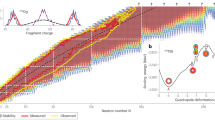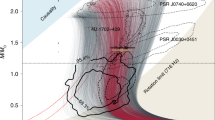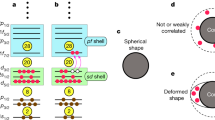Abstract
THE recent report of discovery of superheavy elements1 (with nuclear charges near the predicted values for shell closure, Z= 114 and Z = 126), in surprisingly large quantities in terrestrial material, raises the question of the astrophysical sources for such nuclei. The very lightest nuclei may have been created in the first hours of the big bang, but significant amounts of elements beyond helium could not have been formed in these conditions. The heavier elements must have been formed in stars, and those as massive as uranium were probably formed by intense neutron bombardment immediately before or accompanying supernova explosions2. It seems unlikely, however, that superheavy nuclei could have been formed in this way, since attempts to reach the ‘stability islands’ by successive neutron captures must proceed by nuclei with very short lifetimes. This would almost Certainly be the case for the island about Z = 126, if not for that at Z= 114. I would suggest that neutron stars might be a source for such superheavy nuclei.
This is a preview of subscription content, access via your institution
Access options
Subscribe to this journal
Receive 51 print issues and online access
$199.00 per year
only $3.90 per issue
Buy this article
- Purchase on Springer Link
- Instant access to full article PDF
Prices may be subject to local taxes which are calculated during checkout
Similar content being viewed by others
References
Nature, 261, 627 (1976); Gentry, R. V., et al., Phys. Rev. Lett., 37, 11–15 (1976).
Trimble, V. T., Rev. mod. Phys., 47, 877–976 (1975).
Mayer, M. G., and Teller, E., Phys. Rev., 76, 1226–1231 (1949).
Dyson, F., Neutron Stars and Pulsars, Lecture 5. (Accademia Nazionale Dei Lincei, Rome, 1971).
Latimer, J. M., and Schramm, D. N., Astrophys. J. Lett., 192, L145–L147 (1974).
Author information
Authors and Affiliations
Rights and permissions
About this article
Cite this article
MURPHY, G. Do superheavies come from neutron stars?. Nature 263, 114–115 (1976). https://doi.org/10.1038/263114b0
Received:
Accepted:
Issue Date:
DOI: https://doi.org/10.1038/263114b0
This article is cited by
-
Expansion of neutron star matter and its final nuclear composition
Astrophysics and Space Science (1980)
Comments
By submitting a comment you agree to abide by our Terms and Community Guidelines. If you find something abusive or that does not comply with our terms or guidelines please flag it as inappropriate.



